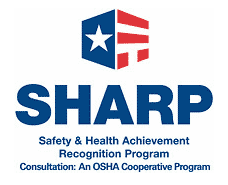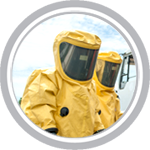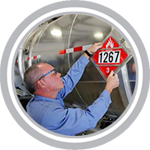Hazardous Material/Waste Training Resources
OSHA Hazardous Material/Waste Response (HAZWOPER)
HAZWOPER stands for Hazardous Waste Operations and Emergency Response and is the OSHA requirement that covers protection of workers responding to hazardous materials spills. The OSHA HAZWOPER Standard (29 CFR 1910.120) includes 3 distinct types of operations and outlines 9 levels of certification.
EPA Hazardous Waste Management (RCRA)
RCRA stands for the Resource Conservation and Recovery Act and contains the EPA-based requirement (40 CFR 261) that covers the proper management of hazardous waste (generation, transportation, treatment, storage or disposal) and its effects on the environment.
DOT Hazardous Material Transportation (Rail/Air/Vessel/Highway)
The Department of Transportation (DOT) defines a hazardous material as a substance or material that is capable of posing an unreasonable risk to health, safety, and property when transported in commerce, and has been designated as hazardous under the federal hazardous materials transportation law (49 U.S.C. 5103).
To find out more information about HAZWOPER, RCRA, and DOT hazardous waste management, check out the items below:
- HAZWOPER
- RCRA
- State HazMat Programs
- OSHA Links
- SHARP
HAZWOPER
Hazardous Waste Operations and Emergency Response (HAZWOPER) is a set of guidelines produced and maintained by the Occupational Safety and Health Administration which regulates hazardous waste operations and emergency services in the U.S. and its territories. With these guidelines, the U.S. government regulates hazardous wastes and dangerous goods from inception to disposal.
The HAZWOPER standard provides employers, emergency response workers, and other workers potentially exposed to hazardous substances information and training criteria to improve workplace safety and health and reduce
The HAZWOPER standard for the construction industry (29 CFR 1926.65) is identical to the federal standard (29 CFR 1910.120).
In limited exceptions, the HAZWOPER standard for construction provides examples or references to other standards for the construction industry that vary from what are provided in the HAZWOPER standard for general industry.
Hazardous waste, as defined by the standard, is a waste (or combination of wastes) according to 40 CFR §261.3 or substances defined as hazardous wastes in 49 CFR §171.8.
Mandatory Required Training
The OSHA HAZWOPER Standard (29 CFR Part 1910.120) – requires that all workers that are exposed to or handle hazardous materials:
- Are required take a 24 hour or 40 hour HAZWOPER Training Course; and
- An 8hr Annual Refresher Course;
- At a level required by their job function and responsibility; and
- Before they are permitted to engage in hazardous waste operations that could expose them to hazardous substances.
All of our courses comply with OSHA regulations. Receive your certification with our 24- or 40-hour course, or renew your HAZWOPER certification with our 8-hour refresher.
Three Levels of HAZWOPER Training
The HAZWOPER regulations contain 3 levels of training for personnel.
- Emergency Response - 29 CFR 1910.120 (q);
- General Site Cleanup - 29 CFR 1910.120 (e); and
- Resource Conservation Recovery Act (RCRA) Treatment, Storage and Disposal Facilities (TSDF) - 29 CFR 1910.120 (p).
Five HAZWOPER Operation Types
The standard describes five operations that fall within the regulation’s scope with three training-types that have unique learning objectives and varying training-hours requirements.
HAZWOPER applies to five groups of employers and their employees. This includes employees who are exposed (or potentially exposed) to hazardous substances (including hazardous waste) and who are engaged in one of the following operations as specified by OSHA 1910.120(a)(1)(i-v) and 1926.65(a)(1)(i-v):
- Cleanup operations required by a governmental body (federal, state, local or other) involving hazardous substances conducted at uncontrolled hazardous-waste sites.
- Corrective actions involving clean-up operations at sites covered by the Resource Conservation and Recovery Act of 1976 (RCRA) as amended (42 U.S.C. 6901 et seq.).
- Voluntary cleanup operations at sites recognized by a federal, state, local, or other governmental body as uncontrolled hazardous-waste sites.
- Operations involving hazardous waste which are conducted at treatment, storage and disposal (TSD) facilities regulated by Title 40 of the Code of Federal Regulations, parts 264 and 265 pursuant to the RCRA, or by agencies under agreement with the U.S. Environmental Protection Agency to implement RCRA regulations.
- Emergency response operations for releases of, or substantial threats of release of, hazardous substances (regardless of the hazard's location).
The most commonly used manual for HAZWOPER activities is Department of Health and Human Services Publication 85–115, Occupational Safety and Health Guidance Manual for Hazardous Waste Site Activities. Written for government contractors and first responders, the manual lists safety requirements for cleanups and emergency-response operations.
HAZWOPER Links
OSHA/Interagency Guidance Documents
- Hazardous Waste Operations and Emergency Response. Publication 3114, (Revised 1997).
- Training Marine Oil Spill Response Workers under OSHA's Hazardous Waste Operations and Emergency Response Standard. Publication 3172, (2001).
- Hospitals and Community Emergency Response - What you need to know. Publication 3152, (1997).
- 29 CFR 1910.120 Appendix E/29 CFR 1926.65 Appendix E. Non-mandatory guidance for general industry to assist employers in developing a site-specific training curriculum to meet HAZWOPER requirements.
- Emergency Action Plans: How to Plan for Workplace Emergencies and Evacuations. OSHA Publication 3088, (2001).
- Best Practices for Hospital-Based First Receivers of Victims from Mass Casualty Incidents Involving the Release of Hazardous Substances. Publication 3249, (2005). This document offers useful information to help hospitals create emergency plans based on worst-case scenarios. It focuses on suggestions for appropriate training and suitable personal protective equipment for healthcare workers who may be exposed to hazardous substances when they treat victims of mass casualties. The document includes appendices with practical examples of decontamination procedures and medical monitoring for first receivers who respond to a mass casualty incident.
- Principal Emergency Response and Preparedness: Requirements and Guidelines. Publication 3122, (2004).
- Incident Command System Resource Center. Federal Emergency Management Agency (FEMA) Emergency Management Institute.
- Safety and Health Awareness for Oil Spill Cleanup Workers. National Environmental Health Sciences, National Institutes of Health (NIH), Department of Health and Human Services (HHS); and Occupational Safety and Health Administration (OSHA), U.S. Department of Labor (DOL). Training tools for employers and workers who will participate in an oil spill response and cleanup operation to ensure workers receive appropriate training and PPE.
For additional resources and information, please reference the Government Agency website directly:
- A-Z Index of All Government Agencies (Includes States)
- Alcohol & Tobacco Tax & Trade Bureau (TTB)
- Bureau of Alcohol, Tobacco, Firearms & Explosives (ATF)
- Bureau of Labor Statistics
- Centers for Disease Control & Prevention (CDC)
- Food & Drug Administration (FDA)
- NAICS Search
- National Institute of Occupational Safety & Health (NIOSH)
- Occupational Safety & Health Administration (OSHA)
- OSHA Establishment Search
- SIC Search
- United States Department of Agriculture (USDA)
- Army Corps of Engineers
- Environmental Protection Agency (EPA)
- Department of Transportation (DOT)
RCRA
The Resource Conservation and Recovery Act (RCRA) is the federal law that creates the framework for the proper management of hazardous and non-hazardous solid waste. Under the RCRA, the Environmental Protection Agency (EPA) regulates hazardous waste to ensure these wastes are managed in ways that protect human health and the environment.
Mandatory Required Training
The EPA requires RCRA training for “personnel” [40 CFR 260.10 - Definitions] or "all persons who work at, or oversee the operations of, a hazardous waste facility, and whose actions or failure to act may result in noncompliance" - must complete RCRA training within 6 months of initial hire - and take an 8 hour refresher training course annually [40 CFR 265.16(b) and (c)].
- 40 CFR §265.16 Personnel training.
- (a) (1) Facility personnel must successfully complete a program ... that teaches them to perform their duties in a way that ensures the facility's compliance with the requirements of this part.
- (b) Facility personnel must successfully complete the program required in paragraph (a) of this section within ... six months after the date of their employment or assignment to a facility, or to a new position at a facility, whichever is later. Employees hired after the effective date of these regulations must not work in unsupervised positions until they have completed the training requirements of paragraph (a) of this section.
- (c) Facility personnel must take part in an annual review of the initial training required in paragraph (a) of this section.
Employers should train all personnel that handle hazardous waste so they are able to properly recognize and manage hazardous wastes in order to identify situations that could cause releases and react quickly to prevent or stop spills.
Hazardous Waste Generators
A generator of hazardous waste is defined at 40 CFR 260.10 as any person, by site, whose act or process produces hazardous waste identified or listed in Part 261 or whose act first causes a hazardous waste to become subject to regulation.
Hazardous waste generators are divided into three categories, based on the amount of waste produced, and are subject to different levels of regulation.
Very Small Quantity Generators/Conditionally Exempt Small Quantity Generators (CESQGs)
- Hazardous Waste Generated - Quantity Limits: ≤ 100 kg/month, and ≤ 1 kg/month of acute hazardous waste, and ≤ 100 kg/month of acute spill residue or soil.
- RCRA Training: Training not mandatory - but recommended so employees can recognize and properly manage hazardous wastes and prevent spills.
- 40 CFR 260.14
Small Quantity Generators
- Hazardous Waste Generated - Quantity Limits: >100 kg/month and <1,000 kg/month
- RCRA Training: Basic RCRA training required.
- 40 CFR 262.16 (b)(9)(iii)
- (iii) The small quantity generator must ensure that all employees are thoroughly familiar with proper waste handling and emergency procedures, relevant to their responsibilities during normal facility operations and emergencies.
Large Quantity Generators
- Hazardous Waste Generated - Quantity Limits ≥1,000 kg/month, or >1 kg/month of acute hazardous waste, or >100 kg/month of acute spill residue or soil
- RCRA Training: Full RCRA training Required
- 40 CFR 262.17(a)(7)
- (7)Personnel training.
- (i)(A) Facility personnel must successfully complete a program of classroom instruction, online training (e.g., computer-based or electronic), or on-the-job training that teaches them to perform their duties in a way that ensures compliance with this part.
- (C) At a minimum, the training program must be designed to ensure that facility personnel are able to respond effectively to emergencies by familiarizing them with emergency procedures, emergency equipment, and emergency systems, including where applicable:
- (1) Procedures for using, inspecting, repairing, and replacing facility emergency and monitoring equipment;
- (2) Key parameters for automatic waste feed cut-off systems;
- (3) Communications or alarm systems;
- (4) Response to fires or explosions;
- (5) Response to ground-water contamination incidents; and
- (6) Shutdown of operations.
- (iii)Facility personnel must take part in an annual review of the initial training required in paragraph (a)(7)(i) of this section.
Reference: EPA: Categories of Hazardous Waste Generators
State Hazardous Waste Programs & Environmental Agencies
Source: EPA
Alabama
Alaska
American Samoa – U.S. Territory
Arizona
Arkansas
- Arkansas Department of Environmental Quality (DEQ)
- Arkansas DEQ Hazardous Waste Division
- Arkansas DEQ Solid Waste Management Division
- Arkansas DEQ Regulated Storage Tanks Division
California
- California Environmental Protection Agency
- California Department of Toxic Substances Control
- California Department of Resources Recycling and Recovery (CalRecycle)
- California Department of Public Health, Medical Waste Management Program
Colorado
- Colorado Department of Public Health & Environment (CDPHE)
- CDPHE Hazardous Materials and Waste Management
Connecticut
- Connecticut Department of Environmental Protection (DEP)
- Connecticut DEP Hazardous Waste
- Connecticut DEP Reduce, Reuse, Recycle website
- Connecticut DEP Pollution Prevention website
- Connecticut DEP Underground Storage Tank Program
Delaware
- Delaware Department of Natural Resources & Environmental Control (DNREC)
- Delaware DNREC Division of Waste and Hazardous Substances
- Delaware DNREC Solid and Hazardous Waste website
- Delaware DNREC Underground Storage Tank Compliance Program
District of Columbia – Washington DC
Florida
- Florida Department of Environmental Protection (DEP)
- Florida DEP Waste Management
- Florida DEP Bureau of Petroleum Storage Systems
- Florida Department of Health – Biomedical Waste
Georgia
- Georgia Department of Community Affairs – Environmental Management
- Georgia Department of Natural Resources (DNR)
- Georgia DNR Environmental Protection Division
Guam – U.S. Territory
Hawaii
Idaho
Illinois
- Illinois Environmental Protection Agency (EPA)
- Illinois EPA Land Pollution and Waste Disposal for Businesses
- Illinois EPA Waste Management for Government
- Illinois EPA Land Pollution and Waste Disposal for Citizens
Indiana
Iowa
Kansas
- Kansas Department of Health and Environment (DHE)
- Kansad DHE Division of the Environment
- Kansas DHE Bureau of Waste Management
- Kansas DHE Storage Tank Section
Kentucky
Louisiana
- Louisiana Department of Environmental Quality (DEQ)
- Louisiana DEQ Solid Waste web page
- Louisiana DEQ Hazardous Waste web page
Maine
- Maine Department of Environmental Protection (DEP)
- Maine DEP Hazardous Waste and Universal Waste website
- Maine DEP Solid Waste Management
Maryland
Massachusetts
- Massachusetts Department of Environmental Protection (DEP)
- Massachusetts DEP Waste and Recycling website
- Massachusetts DEP Hazardous Waste Management website
Michigan
Minnesota
Mississippi
Missouri
- Missouri Department of Natural Resources (DNR)
- Missouri DNR Hazardous Waste Program
- Missouri DNR Solid Waste Management Program
Montana
- Montana Department of Environmental Quality (DEQ)
- Montana DEQ Recycling and Waste Reduction website
- Montana DEQ Hazardous Waste Program
Nebraska
Nevada
New Hampshire
- New Hampshire Department of Environmental Services (DES)
- New Hampshire DES Pollution Prevention website
- New Hampshire DES Hazardous Waste Management website
- New Hampshire DES Household Hazardous Waste website
New Jersey
- New Jersey Department of Environmental Protection (DEP)
- New Jersey DEP Solid and Hazardous Waste Management Program
New Mexico
New York
- New York Department of Environmental Conservation (DEC)
- New York DEC Waste Management website
- New York DEC Recycling and Composting website
North Carolina
- North Carolina Department of Environment and Natural Resources (DENR)
- North Carolina DENR Environmental Assistance and Outreach
North Dakota
Northern Mariana Islands – U.S. Territory
Ohio
Oklahoma
Oregon
- Oregon Department of Environmental Quality (DEQ)
- Oregon DEQ Hazardous Waste website
- Oregon DEQ Solid Waste website
- Oregon DEQ Tanks website
Pennsylvania
- Pennsylvania Department of Environmental Protection (DEP)
- Pennsylvania DEP Waste Programs website for Businesses
- Pennsylvania DEP Recycling and Disposal website for Citizens
- Pennsylvania DEP Storage Tanks website for Businesses
Puerto Rico – U.S. Commonwealth
Rhode Island
- Rhode Island Department of Environmental Management (DEM)
- Rhode Island DEM Office of Waste Management
- Rhode Island DEM Pollution Prevention Program
South Carolina
- South Carolina Department of Health and Environmental Control (DHEC)
- South Carolina Department of Health and Environmental Control – Environment
- South Carolina DHEC Land and Waste Management
- South Carolina DHEC Underground Storage Tanks website
South Dakota
- South Dakota Department of the Environment and Natural Resources (DENR)
- South Dakota DENR Hazardous Waste Program
- South Dakota DENR Solid Waste Program
- South Dakota DENR Reduce, Reuse, Recycle website
Tennessee
- Tennessee Department of Environment & Conservation
- Tennessee Department of Environment & Conservation Hazardous Waste Management website
Texas
Trust Territories
Utah
- Utah Department of Environmental Quality (DEQ)
- Utah DEQ Division of Waste Management and Radiation Control
Vermont
Virginia
- Virginia Department of Environmental Quality (DEQ)
- Virginia DEQ Recycling and Litter Prevention website
- Virginia DEQ Land Protection & Revitalization website
Virgin Islands – U.S. Territory
- No entries available
Washington
- Washington Department of Ecology
- Washington Department of Ecology Waste & Toxics
- Washington Department of Ecology Waste 2 Resources website
Washington, DC – The District of Columbia
West Virginia
- West Virginia Department of Environmental Protection (DEP)
- West Virginia DEP Water and Waste website
- West Virginia DEP Pollution Prevention and Open Dump Program
Wisconsin
Wyoming
OSHA Federal and State Links
U.S. DOL Occupational Safety and Health Administration (OSHA) works to prevent injuries and protect the health of workers.
- US DOL Occupational Safety and Health Administration (OSHA), including the laws, regulations, and services.
- US DOL Employment Law Guide - Occupational Safety and Health
- Bureau of Labor Statistics
- Environmental Protection Agency
- National Institute for Occupational Safety and Health (NIOSH)
- Mine Safety and Health Administration (MSHA)
- National Transportation Safety Board (NTSB)
- Centers for Disease Control and Prevention, Injury and Violence Prevention and Control
- Children’s Safety Network
- Federal Emergency Management Agency
- National Highway Traffic Safety Administration
- National Safety Council
- Safe States
Chemical Information
- OSHA Occupational Chemical Database
- Toxnet – National Library of Medicine Toxicology Data Network
- Agency for Toxic Substances and Disease Registry (ATSDR)
- NIOSH Pocket Guide to Chemical Hazards
MSDS Sites
Nonprofit Organizations and Standards
- American Red Cross
- Electrical Safety Foundation
- National Safety Council
- American National Standards Institute (ANSI)
- National Fire Prevention Association
- Industrial Truck Standards Development Foundation
- American Welding Society
Training
- The Pacific Northwest OSHA Education Center (Seattle)
- Boise State University Center for Excellence for Environmental Health and Safety
- Rocky Mountain Center for Occupational and Environmental Health
- OSHA E-Tools (Web-Based Training Tools)
- Compliance Guidance on Training
- Heat Illness Educational Resources
- Stop Falls Educational Materials and Resources
- OSHA Educational Downloadable Videos
- OSHA Educational Publications
- New Compliance Assistance Products
- Alliance Program Participants Developed Products
- Training and Reference Materials Library
- Other Resources for Training
- Spanish Language Compliance Assistance Resources
- Introduction to OSHA
- Construction Focus Four Training
Safety Professional Organizations
- Snake River Chapter of the American Society of Safety Engineers
- American Board of Industrial Hygiene
- Board of Certified Safety Professionals
Other Safety Information
- OSHA Site Specific Targeting List
- Bureau of Labor Statistics Injury and Illness Data
- Mesothelioma Center
- SafetyInfo.com
- Toolbox Topics
Safety and Health Achievement Recognition Program (SHARP)
 The Safety and Health Achievement Recognition Program (SHARP) is designed to provide incentives and support to employers to develop, implement and continuously improve effective safety and health programs at their worksite. SHARP provides recognition for employers who demonstrate exemplary achievements in workplace safety and health. These companies are exempted from a general scheduled Federal OSHA inspection for one to two years.
The Safety and Health Achievement Recognition Program (SHARP) is designed to provide incentives and support to employers to develop, implement and continuously improve effective safety and health programs at their worksite. SHARP provides recognition for employers who demonstrate exemplary achievements in workplace safety and health. These companies are exempted from a general scheduled Federal OSHA inspection for one to two years.
How Can My Company Participate In SHARP?
To participate in SHARP, you must:
- Request a consultation visit that involves a complete hazard identification survey;
- Involve employees in the consultation process;
- Correct all hazards identified by the consultant;
- Implement and maintain a safety and health management system that, at a minimum, addresses OSHA’s 1989 Safety and Health Program Management Guidelines;
- Lower your company’s Lost-Workday Injury and Illness rate (LWDII) and Total Recordable Case Rate (TRCR) below the national average; and
- Agree to notify your state Consultation Project Office prior to making any changes in the working conditions or introducing new hazards into the workplace
For more information, visit the OSHA web page for SHARP programs.



